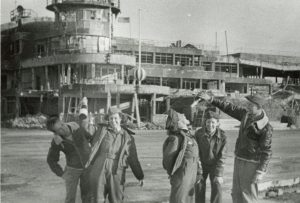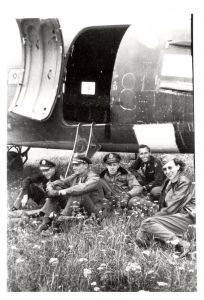Sixth in a Series of Ten Blogs offering A Short History of Nursing from antiquity through the
mid-twentieth century. Part 1 – From Sacred to Secular – covers nursing in ancient
times through the Crimean War. Part 2 – From Civilian to Military – continues with
the establishment of the Saint Thomas School of Nursing through World War II.
A Short History of Nursing
Through World War II
Part 2 From Civilian to Military Nurses
Saint Thomas School of Nursing
Before Nightingale even had arrived in the Crimea, she was already a heroine in the British press. High public expectations for this leader of nurses in a military wartime setting gave rise to the myth of the Lady with the Lamp who almost singlehandedly reversed the high mortality rate of the soldiers that she found in the crowded army hospitals. Sidney Herbert channeled the public’s eagerness to pay tribute to Nightingale into a subscription fund to establish a training school for nurses, the project that Nightingale had in mind before the war. Tooley notes that the excerpt that Herbert read from a letter about a soldier who, seeing Nightingale on her nightly rounds in Scutari, would kiss her shadow as it fell, never failed to bring down the house and unloose purse strings at meetings throughout England. 1 The fund raised over forty-four thousand pounds with both the Church and the army as major contributors. 2
After the last patient was evacuated from her hospitals in the Crimea in 1856, Nightingale returned to England and applied herself not to nurse training, but to improving the health of the British Army through sanitary reform. That training nurses no longer was a priority for Nightingale created an awkward situation for Herbert and the trustees appointed to administer the Nightingale Fund, which lay dormant for years. Under pressure from Herbert, who suggested using the Fund to finance nurse training at King’s College Hospital, where the Saint John’s House sisters had taken over the nursing responsibilities, Nightingale finally agreed to implement her program of nurse training at Saint Thomas Hospital, where Matron Sarah Elizabeth Wardroper, who was not a nurse, had a reputation for good management. Bostridge notes that it was “a solution of reduced expectations, shaped by compromise, and out of Florence’s reluctance at the time to be either actively or regularly involved.” 3 Although she once had thought of establishing a Protestant sisterhood of nurses, Nightingale now believed – perhaps based on her experience with the Catholic nuns and Anglican sisters in Scutari – that nursing required a secular context to move forward as a profession.
The first class of probationers was drawn from the working-class nurses currently on staff of Saint Thomas when the Nightingale Training School opened in 1860. Many of the candidates were unsuited for the program, and the dropout rate was high. Five years into the program, Nightingale introduced a two-tier system of training; regular probationers, mostly from the lower middle class, were paid a stipend with uniforms and board for a three-year course of training, while lady probationers from the upper classes paid for the privilege of a year of training and were placed on the fast track to become ward sisters and matrons. The Nightingale name assured a continuing supply of applicants, and by the 1880s, most London teaching hospitals had training schools for nurses. Ironically, Saint Thomas Hospital became the last of the teaching hospitals to hire a trained nurse as lady superintendent.
With Mrs. Wardroper as matron, the Nightingale Training School initially offered neither a clean break with the past nor a fresh start in nursing reform. Under the old or ward system of nursing, the matron was not a nurse, nor even a “lady,” but rather a housekeeper and an administrator whose duties did not involve direct patient care. Sisters ran the wards, but medical staff trained the nurses in tasks allotted to them. Once put into effect, the Nightingale system centralized nursing under the control of the matron, now a trained nurse and gentlewoman who had been a lady probationer. It was she who oversaw nursing on the wards and nurse training. With sisters and nurses no longer answerable to the medical staff, doctors had lost control of the wards and of nursing. A newly implemented change that rotated probationers through the wards for experience – borrowed from the Kaiserwerth model – caused discontent among medical staff who aired their grievances in the press.
In an 1880 issue of The Nineteenth Century, Margaret Lonsdale, a lady probationer at Guy’s Hospital in London, castigates the old system of ward nursing, claiming that the permanently assigned nurses were immoral and often drunk, and favors the new model of nursing in which nurses are circulated throughout the wards every three months. 4 Her views occasioned an immediate response from the medical community casting aspersions on her credibility to make such claims, given that she had been on the ward only a few weeks. The exchange highlights problems nurses faced when trying to carve out an area of the medical field as their own when boundaries were permeable, and the reluctance of medical staff to accept the new model of nursing when it seemed to disadvantage rather than facilitate patient care and comfort. Upstarts in nursing had no right to claim that they knew better than the physicians and surgeons what was best for the patient, the medical men responding to Lonsdale’s article insisted. A contentious issue was the “higher nursing” such as bandaging, dressing wounds, and supervising curative baths that medical students were performing, which was “essential to the existence of the medical school,” claimed Walter Moxon, a physician and lecturer at Guy’s, in The Contemporary Review the following month. 5
Samuel Osborne Haberson, Senior Physician and Lecturer at Guy’s, weighed in with sarcasm:
It is certainly very obstructive to all the minute and meddlesome details of the new system to have [medical] students watching their patients at all hours, and the nursing according to modern theories might be carried on more freely if these gentlemen were altogether absent. The duties which they have been accustomed to perform would then be left for the lady pupil, and this would accord far better with the ideas of the new system. … Should the fashionable mania for nursing have full sway according to the theories of Miss Lonsdale, the physician himself would be scarcely required. 6
Lonsdale, who was given the last word, attempted to make “honourable amends” for “unnecessary and unintentional cause of offence to the doctors” in her original article of April 1880. She had not intended, the author stated, to imply “that in some ways the nurse knows better than the doctor what is good for the patient.” Indeed, “the doctor must remain absolutely supreme.” 7 Lonsdale’s capitulation plays into the stereotype of nurse as handmaiden of the doctor, discussed in the next chapter, as well as a division of labor along gender lines marked by familial patriarchy with doctor as father, nurse as mother, and patient as child. In this ideology, the nurse “naturally” took on the domestic roles of motherhood. 8 Eva Gamarnikow suggests that for doctors, obedience was the most important quality in a nurse, for it “signified both the servile status of nursing and the dominant status of medicine within the social organisation of health care.” 9 The subordinate role of the nurse was important at a time when medical men perceived a threat in organizational and training reform that could turn nurses into quasi-medical, independent occupational practitioners similar to what had happened to apothecaries and surgeons. 10
To Gamarnikow, nursing reform highlighted the gendering of nursing. In the power relations inherent in hospital nursing, “Since nurses were subordinate to doctors, and women to men, ‘natural’ female subservience to men could secure professional subservience to medicine. Thus, the nurse’s skills and abilities were collapsed into female obedience to the male doctor.” 11 Nurses, however, turned this gendering into an enabling “femininity in action” to justify their entrance into the sphere of medicine by appropriating tasks resembling women’s work at home and then using their “feminine wiles” to tie the doctors around their proverbial little fingers. Such manipulative tactics mitigated their subordinate status. 12
By the end of the century, Nightingale believed that the best nursing could be done not in hospitals but in the patients’ homes. Her popular Notes on Nursing first published in 1859 was not intended as a textbook for hospital nurses – though it was used as one – but rather as a primer for non-nurses such as domestic servants who might be called on to nurse members of the household. Nightingale’s goal to keep patients out of hospital through preventative measures such as provision of fresh air, light, cleanliness, and diet that enabled Nature to effect a cure suggests a holistic nursing approach both ancient and modern. England’s young women, however, were of a different mind, and by the end of the nineteenth century, teaching hospitals were turning away applicants for nurse training when supply far exceeded demand.
“Nursing has become one of the fashionable crazes of the day,” wrote Amy Woods in The Girl’s Own Paper, a popular London weekly, in 1893, “and almost every girl seems to imagine she is a born nurse. As a refuge for discontented and dissatisfied women, the hospitals and training institutions seem to have taken the place of the sisterhoods, possibly because no vows are enforced on those who enter them, and masculine society is not prohibited.” 13 Nightingale nursing, which had gotten off to a slow start, had caught on and had spread throughout England and to North America by the end of the century. Although Nightingale may not have originated nurse training, she is credited with having popularized it in the eyes of the public. A Punch cartoon satirizes the strong attraction that hospital nursing had for England’s misguided young women in the late nineteenth century. In “Charity That Beginneth Not Where It Should,” a young woman says: “Well, you see, it’s so dull at home, Uncle. I’ve no Brothers or Sisters – and Papa’s paralysed – and Mamma’s going blind – so I want to be a Hospital Nurse.” 14
“The Victorian public adored womanly self-sacrifice,” Vicinus writes, though, as Punch indicated, that self-sacrifice could be misdirected. She continues:
Nurses captured the public imagination; they were surrogates for those who could not or would not give up their own lives for others. In an age that was widely condemned for its materialistic and self-seeking character, women – and especially nurses – carried the burden of morality for others. Nurses were as close to saints as a Protestant country could have. 15
At no time was this more evident than during war when Nightingale and her nurses offered their “welcomed sympathy and small comforts” to the sick and wounded soldiers in the Crimea – male orderlies did most of the actual nursing. But, as Dingwall points out, it was less what the nurses did “than the image built around them that was consequential.” 16 That image extended to the American Civil War in the next decade (1861–1865) when an anonymous contributor to Harper’s Weekly wrote, “This war of ours has developed scores of Florence Nightingales, whose names no one knows, but whose reward, in the soldier’s gratitude and Heaven’s approval, is the highest guerdon woman can ever win.” 17
To learn how the history of nursing was reflected on the opera stage, see Judith Barger, The Nurse in History and Opera: From Servant to Sister (Lexington Books, 2024).
Notes
- Tooley, History of Nursing, 923.
- Bostridge, Florence Nightingale, 294.
- Ibid., 367.
- Margaret Lonsdale, “The Present Nursing Crisis at Guy’s Hospital,” The Nineteenth Century: A Monthly Review 7 (April 1880): 677–84.
- W. [Walter] Moxon, “Miss Lonsdale on Guy’s Hospital,” The Contemporary Review 37 (May 1880): 886. See also William Gull, “On the Nursing Crisis at Guy’s Hospital I,” The Nineteenth Century: A Monthly Review 7 (May 1880): 884–91; Alfred G. Henriques, “On the Nursing Crisis at Guy’s Hospital III,” The Nineteenth Century: A Monthly Review 7 (May 1880): 902–904; Octavius Sturges, “Doctors and Nurses I,” The Nineteenth Century: A Monthly Review 7 (June 1880): 1089–96; Seymour J. Sharkey, “Doctors and Nurses II,” The Nineteenth Century: A Monthly Review 7 (June 1880): 1097–1104; and Adrienne Knight, “The Great Nursing Dispute of Guy’s Hospital 1879–1880,” Journal of the Royal College of Physicians of London 31 (2) (March / April 1997): 208–14.
- S.O. Habershon, “On the Nursing Crisis at Guy’s Hospital II,” The Nineteenth Century: A Monthly Review 7 (May 1880): 898–99. Italics original.
- Margaret Lonsdale, “Doctors and Nurses III,” The Nineteenth Century: A Monthly Review 7 (June 1880): 1l05.
- Eva Gamarnikow, “Sexual Division of Labour: The Case of Nursing,” in Feminism and Materialism: Women and Modes of Production, ed. Annette Kuhn and AnnMarie Wolpe (London: Henley, 1978), 110.
- Ibid., 116.
- Ibid., 104.
- Ibid., 124.
- Ibid., 126–28.
- Amy Woods, “Modern Girls,” The Girl’s Own Paper 14 (6 May 1893): 500.
- “Charity That Beginneth Not Where It Should,” Punch (7 December 1889): 267.
- Vicinus, Independent Women, 112.
- Dingwall, Rafferty, and Webster, Social History of Nursing, 47. “Our Women and the War,” Harper’s Weekly 6 (6 September 1862): 570.
- “Our Women and the War,” Harper’s Weekly 6 (6 September 1862): 570.
Featured Image:
the-australian-national-maritime-museum-9cHrXOvbj38-unsplash.jpg



